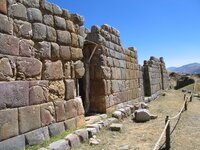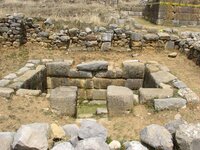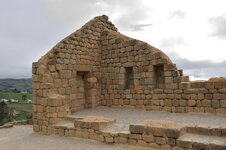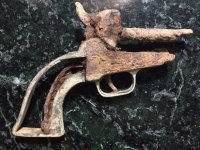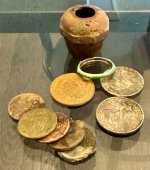Crow
Silver Member
- Jan 28, 2005
- 3,325
- 9,293
- Detector(s) used
- ONES THAT GO BEEP! :-)
- Primary Interest:
- Other
Hello
Legends and dreams of fortune and glory is no modern phenomenon in South America from the day the conquistadors arrived people have been dreaming of fortune and glory ever since.
Stories of such wealth has abound in such journals. The following story in one such story.
RUINS OF PERU.
(From an American Paper.)
PIZARRO.-The following communication read before the Academy of Natural Sciences Philadelphia, on the 14th ultimo, by J, Quinby, corresponding member claims
'' It was reported in Chili that the Inca the Temple of the Sun, which, at the time of the conquest of Peru, the natives had concealed from the Spaniards, have lately been recovered near the Cerrio de Pasco, in Peru The value of them has been calculated about 180,000,000 dollars."
The palace of the Inca and the Temple of the Sun, here referred to, we presume to la Huanuco Viejo, which is situated on the top side of the Andes, twenty leagues north of the Cerrio de Pasco, and on the right bank of the river Chucabainbn, one of the life branches of the Amazons (Maranon), atitude elevation of 14,000 feet above the level of the ocean, in latitude 108 south, and longitude 74 degrees west, nearly. It is known when Pizarro, now more than three centuries ago, took the Temple of the Sun at Cuzco which is some twelve degrees south of that Huanuco Viejo, and despoiled the Inca of immense treasures of gold, and, finally, with threats could extort no more, put him treacherously to death, the Inca of Huamti Viejo, advised of what had taken place in Cuzco, secreted the jewels of the temple and the gold of his palaces in the fastnesses of the Andes and the neighbouring rivers and lakes.
Avarice and ambition have made these hidden treasures objects of continued search from the days of Pizarro to the present time." But as yet no clue has been found to this Eldorado?
unless the above announcement is well founded, which we are inclined to doubt.
The writer has been five different times to these magnificent ruins, and always found persons employed in their vicinity, searching for the hidden treasure of the Incas. The whole of the river Chucabamba, for a number of leagues above and below the Temple of the Sun, is auriferous, and the inhabitants of the province of Huamelies, through which it passes, obtain by washing the sand and by means of sheep skins, 200,000 or 300,000 dollars annually. The wool on the skin is shrunk until it is about half an inch in length. The skins are then anchored down with the wool side up, by means of loose stones placed ti them, in and below the various falls and pools in which position they are suffered to remain from six to twenty-four hours. They are then carefully raised out of the water turned wool side downwards into a bucket or (tub) of water, and thoroughly washed,* gold falling from the wool of the skin, and is finally collected from the bottom of the. Sheep were unknown to the Inca. and us they had obtained an immense amount of gold from this Peruvian stream, it is presumed that they used the skins of the Lama and alpacas.
When we reflect on the fact that the Incas and Spaniards have obtained by Hand washings on this river during two or more centuries 100,000 dollars, 200,000 dollars, 300,000 dollars of gold annually recorded by the Spanish alone, and that might have not probably secured the one-hundred, pall of the Amount that has passed through the current of the stream, we may form an imperfect idea of the exhaust-less source of this perennial supply. The stupendous Andes are alone capable of furnishing such countless riches.
We shall not attempt a description of the magnificent Temple of the Sun at Huanuco Viejo, its powerful Inca fortress, and the ruins of the great city which they overlook. When and by whom they were built neither history nor tradition informs us. The Incas had_ no written language, and we are left to conjecture. But their great magnitude and massive walls, composed of huge blocks of square, oblong, and elegantly wrought marble, green . stone, and green stone porphyry, weighing many tons, bear mute but eloquent testimony to the untiring industry of the Incas, and their advances in the arts of civilization. The ravages and earthquakes of centuries have left' these monuments almost as perfect as they were when Pizarro conquered Peru. Even the great earthquake which destroyed the city of Callao, built by the Spaniards, with its 30,000 inhabitants, did not throw down the massive walls of the Temple of the Sun ; and the writer can testify that they withstood, with slight injury, the great earthquake of March 30, 1828. The Seraglio and its various compartments, with the exception of the roof, and the voluptuous baths for a numerous train of wives, cut out of massive rocks, arc almost as entire as they were on the landing of Pizarro.
Early illustration of Inca Sun temple site Huanuco Viejo
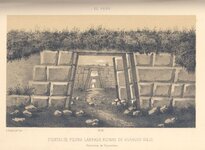
Early 1842 newspaper story.
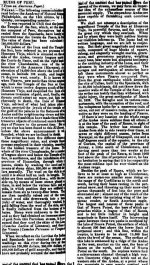
Today the site is still rather intact all be it a little run down with age.
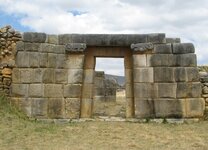
Is there any truth to the alleged 1842 discovery? Does the river still provide a golden bounty? And is there somewhere around the hills and lakes of this mysterious Inca site a vast Inca treasure still awaiting discovery?
Crow
Legends and dreams of fortune and glory is no modern phenomenon in South America from the day the conquistadors arrived people have been dreaming of fortune and glory ever since.
Stories of such wealth has abound in such journals. The following story in one such story.
RUINS OF PERU.
(From an American Paper.)
PIZARRO.-The following communication read before the Academy of Natural Sciences Philadelphia, on the 14th ultimo, by J, Quinby, corresponding member claims
'' It was reported in Chili that the Inca the Temple of the Sun, which, at the time of the conquest of Peru, the natives had concealed from the Spaniards, have lately been recovered near the Cerrio de Pasco, in Peru The value of them has been calculated about 180,000,000 dollars."
The palace of the Inca and the Temple of the Sun, here referred to, we presume to la Huanuco Viejo, which is situated on the top side of the Andes, twenty leagues north of the Cerrio de Pasco, and on the right bank of the river Chucabainbn, one of the life branches of the Amazons (Maranon), atitude elevation of 14,000 feet above the level of the ocean, in latitude 108 south, and longitude 74 degrees west, nearly. It is known when Pizarro, now more than three centuries ago, took the Temple of the Sun at Cuzco which is some twelve degrees south of that Huanuco Viejo, and despoiled the Inca of immense treasures of gold, and, finally, with threats could extort no more, put him treacherously to death, the Inca of Huamti Viejo, advised of what had taken place in Cuzco, secreted the jewels of the temple and the gold of his palaces in the fastnesses of the Andes and the neighbouring rivers and lakes.
Avarice and ambition have made these hidden treasures objects of continued search from the days of Pizarro to the present time." But as yet no clue has been found to this Eldorado?
unless the above announcement is well founded, which we are inclined to doubt.
The writer has been five different times to these magnificent ruins, and always found persons employed in their vicinity, searching for the hidden treasure of the Incas. The whole of the river Chucabamba, for a number of leagues above and below the Temple of the Sun, is auriferous, and the inhabitants of the province of Huamelies, through which it passes, obtain by washing the sand and by means of sheep skins, 200,000 or 300,000 dollars annually. The wool on the skin is shrunk until it is about half an inch in length. The skins are then anchored down with the wool side up, by means of loose stones placed ti them, in and below the various falls and pools in which position they are suffered to remain from six to twenty-four hours. They are then carefully raised out of the water turned wool side downwards into a bucket or (tub) of water, and thoroughly washed,* gold falling from the wool of the skin, and is finally collected from the bottom of the. Sheep were unknown to the Inca. and us they had obtained an immense amount of gold from this Peruvian stream, it is presumed that they used the skins of the Lama and alpacas.
When we reflect on the fact that the Incas and Spaniards have obtained by Hand washings on this river during two or more centuries 100,000 dollars, 200,000 dollars, 300,000 dollars of gold annually recorded by the Spanish alone, and that might have not probably secured the one-hundred, pall of the Amount that has passed through the current of the stream, we may form an imperfect idea of the exhaust-less source of this perennial supply. The stupendous Andes are alone capable of furnishing such countless riches.
We shall not attempt a description of the magnificent Temple of the Sun at Huanuco Viejo, its powerful Inca fortress, and the ruins of the great city which they overlook. When and by whom they were built neither history nor tradition informs us. The Incas had_ no written language, and we are left to conjecture. But their great magnitude and massive walls, composed of huge blocks of square, oblong, and elegantly wrought marble, green . stone, and green stone porphyry, weighing many tons, bear mute but eloquent testimony to the untiring industry of the Incas, and their advances in the arts of civilization. The ravages and earthquakes of centuries have left' these monuments almost as perfect as they were when Pizarro conquered Peru. Even the great earthquake which destroyed the city of Callao, built by the Spaniards, with its 30,000 inhabitants, did not throw down the massive walls of the Temple of the Sun ; and the writer can testify that they withstood, with slight injury, the great earthquake of March 30, 1828. The Seraglio and its various compartments, with the exception of the roof, and the voluptuous baths for a numerous train of wives, cut out of massive rocks, arc almost as entire as they were on the landing of Pizarro.
Early illustration of Inca Sun temple site Huanuco Viejo

Early 1842 newspaper story.

Today the site is still rather intact all be it a little run down with age.

Is there any truth to the alleged 1842 discovery? Does the river still provide a golden bounty? And is there somewhere around the hills and lakes of this mysterious Inca site a vast Inca treasure still awaiting discovery?
Crow


